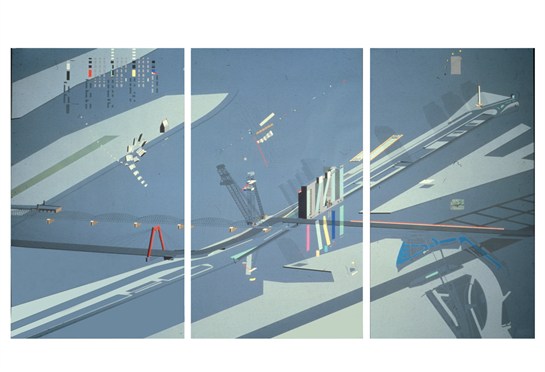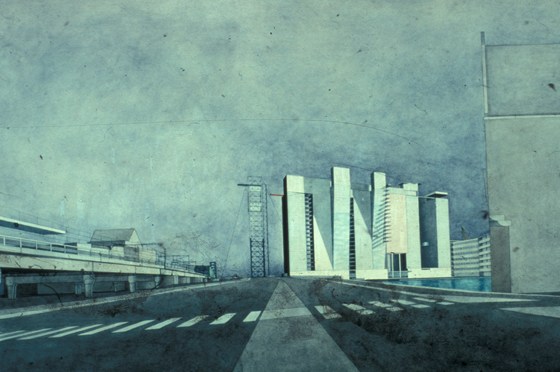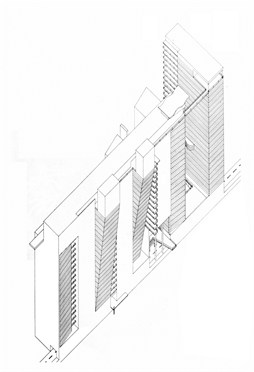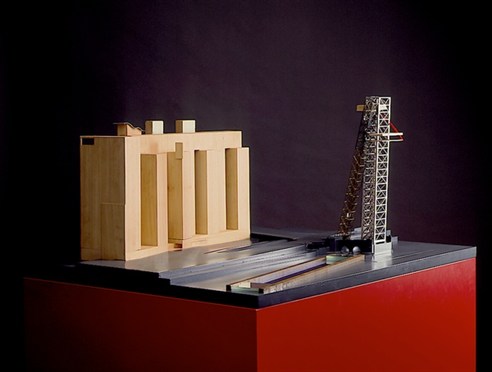A series of residential towers on the Maas River in Rotterdam is a proposal by OMA for Municipality of Rotterdam in 1980. It is located in Rotterdam Netherlands in an urban setting. Its scale is large.
At the end of 1980 OMA was asked by the city of Rotterdam to conduct a study of high rise building in the city, and to illustrate the investigations with a planning proposal for a site in the centre. In consultation with the Town Planning Department, a site was selected on the Maasboulevard along near the Maasbridges. We see the angle between the river and the lower side of the grid as a ‘hinge’ between the city and the river. Here the river is closest to the centre. The shifting of the centre through the injection of gigantic buildings in the second reconstruction makes this point most suitable to take over the role of the ‘window’ in the disclosing of the riverfront. The site is peculiar.
On one hand it is embedded in a network of traffic lanes, like the new suspension bridge across the Maas whose approach makes its way into the city through two inexplicable twists. On the other hand there lies a unique opportunity to connect the river with the city. The city is visible, but hardly accessible; any structure will be noted in passing, at bewilderingly different speeds and angles.
The design in its context
The building and the bridge are designed as an undetachable whole. Built as a composition of towers inserted in a slab, the project carries on the experiments in slaboid mutations and new building types that were done after the war in the bombed areas. It forms a transparent screen along the riverfront. On the riverside the screen acts as a row of stone towers against a glass horizon, introducing a skyline in the Rotterdam skyline, and on the city side it acts as a stone slab with glass towers and slits, that portray pieces of the river.
Due to their different angles, the glass surfaces on the city side reflect the light in different directions and mostly they only reflect air and water, not buildings. The building is designed toward the kinetic experience, caused by the passing of the site with different speeds across the bridges and the boulevard: The towers all have a different angle to the slab: some fall backwards, others are contained, others twist away and the steel tower has altogether escaped.
The average height of the building in 72 meters. For a tower this is not so high, for a slab it is (according to Dutch standards). The composition of these elements in this project claims a fair height to be effective in the skyline of the Rotterdam harbour, where the juxtaposition of extremely high constructions with lower city districts is a frequently appearing image.
Two Structures for Rotterdam 1980-81
The centre of Rotterdam was bombed in 1940: overnight it was turned into a 3 kilometer wide crater. Few buildings survived – one of them (the so-called White House), a 54 meter tower built in 1898 that was for twenty years Europe’s tallest building. Immediately, Rotterdam architects started to plan the eventual ‘reconstruction’ project, which began during the war, which is still incomplete. During the 1950s the new Rotterdam became a paradigm: a CIAM city of slabs that were tied together by a Team X-like ‘connective tissue’ by Bakema, the Lijnbaan.
In the 1960s and 1970s, that emblematic architecture was discredited: on the periphery of the centre, on the other side of the railway track, a second, revisionist reconstruction was started – an assembly of buildings by Piet Blom (a small forest of his tree houses), Bakema and others. The new reconstruction was the absolute opposite of the 1950s effort: where they were sober, ordered and logical; the new city was chaotic and obsessively humanist. The two cities are separated by a ‘fault’, formed by a railway line and a highway that both cross the river at this point. The separation is further reinforced by a new suspension bridge across the Maas whose approach makes its way into the city through two inexplicable twists.
Now that the city nears completion, the riverfront – more precisely, the so-called Maasboulevard, a curved dike that protects the rest of the city – remains under-exploited and is one of the last frontiers for further development. The two structures for Rotterdam are located exactly at this point; they form a ‘cornerstone’ of the old ‘modern’ centre, and face, across the fault, the multitude of anti-modernist revisions.
This project had a triple purpose: to activate the riverfront; to propose a ‘solution’ for the bridgehead of the old bridge that will become redundant after the inauguration of the new one; and to suggest an apartment building for a site against the old bridge. The site is peculiar: one side is quayside, the other is formed by a riverside highway, one the side of a bridge. It is visible, but hardly accessible; any structure on it will be noted in passing, at bewilderingly different speeds and angles.



